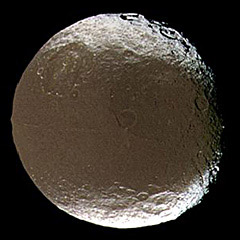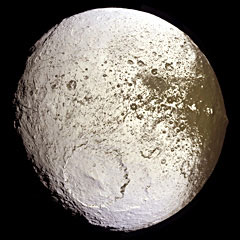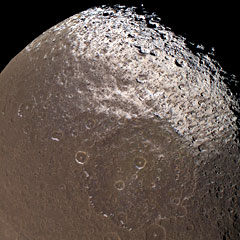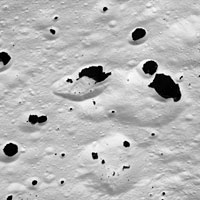 |
 |
 |
||
| Cassini image of Saturn's two-faced moon Iapetus (NASA/JPL/Space Science Institute) |
Cassini image of the light colored side of Iapetus (NASA/JPL/Space Science Institute) |
Cassini close-up view of the dark colored side of Iapetus (NASA/JPL/Space Science Institute) |
| Back to Previous Stop | Return to Titan |
Iapetus | Continue Tour to Other Moons |
Continue to Next Stop |
Son of Uranus
Iapetus [eye-AP-i-tus] is the seventeenth of Saturn's moons and the third largest. It was named after a Greek Titan who was the son of Uranus and the father of Prometheus and Atlas. He was also an ancestor of the human race. According to legend, Iapetus was later imprisoned by Zeus in Tartarus after the rebellion of the Titans against the gods. Iapetus was discovered by Giovanni Cassini in 1671. Most of what we now know this moon came from the Voyager missions.
 |
 |
 |
||
| Cassini close-up showing bright terrain coated with dark material (NASA/JPL/Space Science Institute) |
Cassini view of Iapetus showing light and dark colored mountains (NASA/JPL/Space Science Institute) |
Cassini image with dark material splattered on light terrain (NASA/JPL/Space Science Institute) |
A Moon of Contrast
Iapetus is probably the most unusual of Saturn's moons. It has a low density similar to that of Rhea. This indicates that it contains very little rocky material and is composed mainly of water ice. Iapetus is a moon of stark contrasts. Its leading hemisphere is very dark with a slight reddish color, while its trailing hemisphere is very bright. The dark area is one of the darkest terrains in the Solar System, and is darker than asphalt. The reason for this dark matter on the leading side is not known. It could be composed of dark matter swept up from space, or it could be something that flowed out from within the moon. Some astronomers believe that the dark matter could have originated on Saturn's moon, Phoebe. Phoebe has a low albedo. Material could have been blasted into space by impacts, where it was then deposited on the surface of Iapetus. One problem with this theory, however, is that the color of the material on Phoebe and Iapetus do not match. Another theory states that this dark material may have been formed by eruptions of methane from deep within the moon. The fact that this area is fairly devoid of craters would suggest that this material is replenished regularly. One puzzling aspect of this phenomenon is that the dividing line between the dark and light areas is extremely sharp. No one seems to know why.
 |
| Cassini spacecraft close-up image of Iapetus showing its diverse surface features. The light areas are likely composed of ice. The darker areas represent a thin coating of an unknown material. (ESA/NASA/JPL/University of Arizona) |
Features of Iapetus
The dark, smooth region of Iapetus is known as the Cassini Regio. Very few craters can be found in this region. Astronomers believe that the dark material that covers this region is continually being replenished, thus covering any new craters that may appear. On the opposite side of Iapetus lies the Roncevaux Terra. This region is littered with hundreds of craters. The largest of these craters is known as Roland and is 90 miles (144 km) in diameter. The second largest crater in this area, called Marsilion, is 84 miles (136 km) in diameter. Iapetus has no detectable atmosphere and no magnetic field.
The Sun
Mercury
Venus
Earth
Mars
Jupiter
Saturn
Uranus
Neptune
Pluto
Asteroids
Comets
Interstellar Space
Your Weight on Other Planets
|
||||||||
| Back to Previous Stop | Return to Titan |
Return to Top of Page |
Continue to Next Stop |



